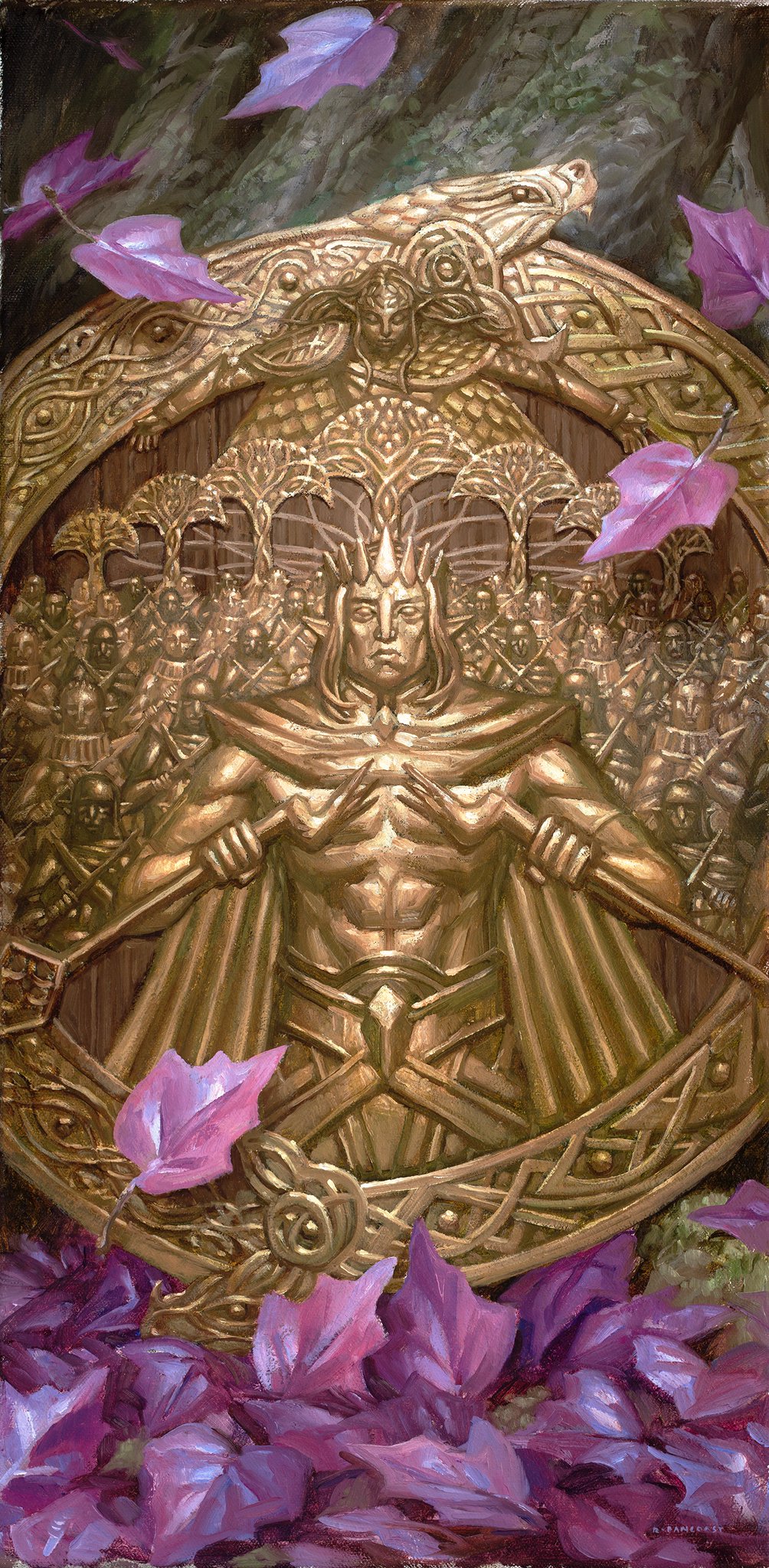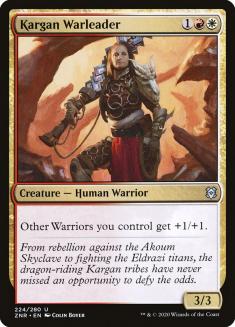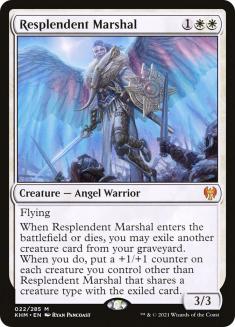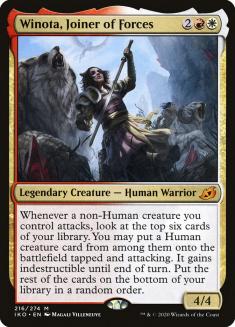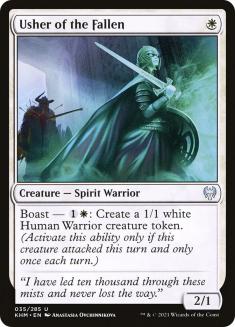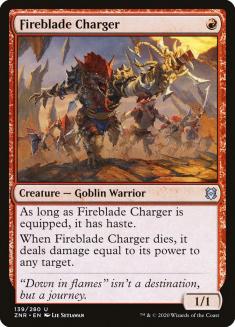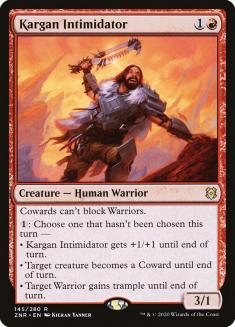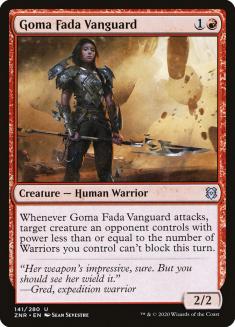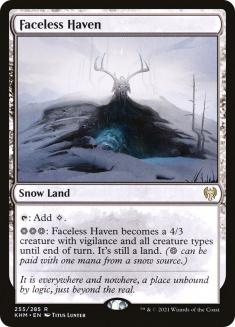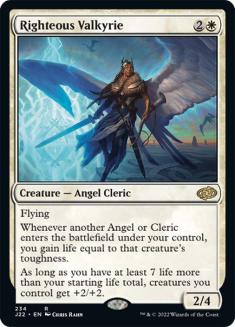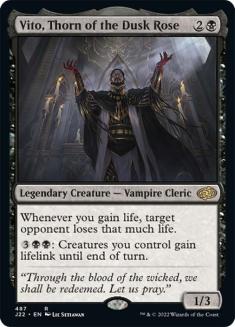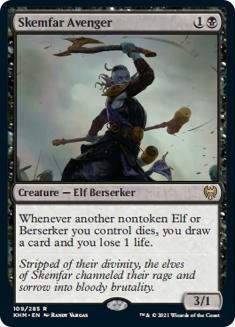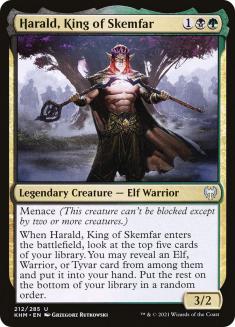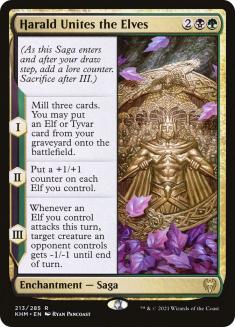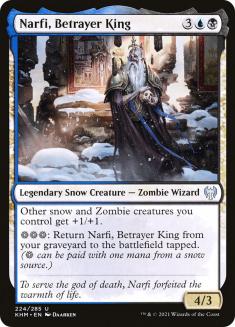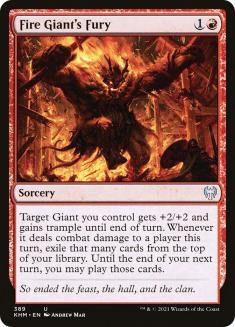Kaldheim brought a lot of support for tribal decks, but do any of them have what it takes in Standard, or will Gruul Adventures with some nice new hasty mythics remain the top aggro deck? The only way to find out is to build them, right?
Warriors
Remember how good Benalish Marshal was? What if it were easier to cast? Kargan Warleader didn’t get any attention because a lord like this really needs one-drops to pump up, and we just didn’t have them before. They’re still in short supply, but Usher of the Fallen is a bit of a game changer here. Fireblade Charger is nothing to write home about, but it’s not embarrassing, especially if you have strong lords to pump it up.
Resplendent Marshal isn’t exactly a second copy of Benalish Marshal, but it’s not exactly worse either. The comparison’s complicated, but the card’s amazing in a tribal deck, especially in Warriors.
Comparison in short: The body on Resplendent Marshal is better since it flies, and it’s much better if your opponent kills it since the boost it gave your creatures sticks. You might be able to net +2/+2 out of it, but the pumping is worse if it lives because it won’t pump creatures you cast after it. And of course, it might not pump at all if nothing’s in your graveyard. All in all, “better if they kill it” is a great place to be for a lord, since killing it is usually your opponent’s top priority.
Winota, Joiner of Forces is clearly the biggest draw here, and it’s a really big draw. One of our lords has flying to pair perfectly with Winota and the other’s a Human to hit off Winota. Both one-drops we want to play happen to not be Humans, while the best two-drop Warriors are Human, which helps our density of hits, which is great, especially because Kargan Intimidator can choose to stop being Human before it attacks.
Look at this core curve of Warriors:
I’m happy to play four copies of each of those cards for a core of 28 great Warriors on a smooth curve, so the trick is just figuring out how to round out the rest of the deck with another roughly eight or nine spells, and this is where things get tricky.
Fortunately, it’s the good kind of tricky, where we have an abundance of great choices.
The easiest option is to fill the deck out with Winota’s best friends, Bonecrusher Giant and Skyclave Apparition. This would give the deck some removal that also happens to give us creatures that can trigger Winota. It can feel a little disappointing to play creatures that don’t benefit from our lords, but just remember they wouldn’t be pumping up Banishing Light or Scorching Dragonfire either.
Another option is to further pump our creatures with any combination of Rally the Ranks, Embercleave, and Maul of the Skyclaves. Our creatures hit hard and both two-drops prevent the opponent from blocking, so do we even need removal? I could certainly see skipping it in the maindeck.
Alternatively, we could try to be a little more curve-conscious and play cheaper interaction like Frost Bite and Giant Killer. About Frost Bite, did I mention that we’re a snow deck? Of course we are, so I wouldn’t want to bench the last Warrior:
With plenty of colorless in our spells’ casting costs, I don’t see any good reason not to play Faceless Haven.
We could also play small numbers of some other powerful cards that would offer a little more top-end, some combination of cards like Haktos the Unscarred and Kenrith, the Returned King to get better Winota hits or Legion Angel.
So what exactly should the deck look like? I’m really torn on those last slots, but maybe something like this:
Creatures (35)
- 2 Bonecrusher Giant
- 4 Winota, Joiner of Forces
- 1 Legion Angel
- 4 Skyclave Apparition
- 4 Goma Fada Vanguard
- 4 Kargan Intimidator
- 4 Kargan Warleader
- 4 Fireblade Charger
- 4 Resplendent Marshal
- 4 Usher of the Fallen
Lands (23)
Spells (2)

Historically, six has felt like a good amount of maindeck removal spells in white aggro decks, and splitting the difference let me make room for a few Embercleaves, where a little can go a long way.
The decision to play Faceless Haven makes me want to avoid DFCs since it’s kind of its own split card/land creature and it doesn’t play well with DFC lands, as they don’t make snow and Faceless Haven needs a lot of snow to function.
This deck is a bit one-dimensional and could struggle with cards like Doomskar. After sideboarding, Maul of the Skyclaves lets you extend with a permanent that sticks around through a sweeper and Showdown of the Skalds helps recover, but I’d definitely prefer not to play against a deck with sweepers with something like this.
Clerics
Righteous Valkyrie looks pretty awesome. A 2/4 flyer for three is an unusual baseline, but it doesn’t seem bad and it looks like this gain a lot of life, which makes the 27-life thing look pretty realistic (and +2/+2 to all your creatures including it is huge game). I’m willing to do some work for this.
Creatures (34)
- 2 Heliod, Sun-Crowned
- 2 Vito, Thorn of the Dusk Rose
- 4 Archfiend's Vessel
- 4 Speaker of the Heavens
- 2 Orah, Skyclave Hierophant
- 4 Cleric of Life's Bond
- 2 Taborax, Hope's Demise
- 4 Skyclave Cleric
- 4 Luminarch Aspirant
- 4 Righteous Valkyrie
- 2 Glorious Protector
Lands (18)
Spells (8)

Archfiend’s Vessel and Speaker of the Heavans both have lifelink, so either can immediately grow Cleric of Life’s Bond and both are great targets for Luminarch Aspirant’s counters.
Righteous Valkyrie is pretty incredible with Vito, Thorn of the Dusk Rose, as all your creatures double as burn spells if you control both and you can even double up on Valkyries to double the life loss. Even without Righteous Valkyrie, this deck has enough ways to gain life that Vito should stand out, and I might not be playing enough copies.
On the other hand, there’s no shortage of awesome three-mana legendary creatures available to this archetype, which makes splitting them up to avoid the legend rule a compelling choice. Heliod, Sun-Crowned isn’t a Cleric but spreading extra counters to your lifelink creatures or giving lifelink to your heavy hitters like Cleric of Life’s Bond and Taborax can really help you hit the magic 27 life. I could also imagine a version of this deck that leans heavier on white just to maximize Heliod and turn it into a creature more often.
Here I did opt for the all-threat maindeck that can’t interact with the opponent’s permanents. This deck can go really big (particularly with flying creatures) or win outside of combat and end games quickly, so I figured I’d start there. The sideboard is literally fifteen removal spells to make up for it, which also might be a little excessive.
Another thing I’m not sure about is the DFCs — specifically, I’m not sure if Skyclave Cleric is better than Malakir Rebirth. I went for Skyclave Cleric here, but there’s another approach where you could play Woe Strider to make better use of Orah and Glorious Protector, and then you might want Rebirth instead since you could use it more proactively.
All in all, I think this deck is likely slightly weaker than Warriors because nothing matches the explosiveness of Winota, but I might be underestimating how great this deck is at 27 life.
Elves
Creatures (32)
- 4 Wildwood Tracker
- 4 Wildborn Preserver
- 4 Llanowar Visionary
- 4 Elvish Warmaster
- 4 Skemfar Shadowsage
- 4 Harald, King of Skemfar
- 4 Jaspera Sentinel
- 4 Skemfar Avenger
Lands (19)
Spells (9)

Skemfar Avenger seem awesome, but its strength is limited by its vulnerability to Bonecrusher Giant. Fortunately, Elves is far from reliant on Skemfar Avenger for its card advantage, as Harald, King of Skemfar and Llanowar Visionary are both excellent three-drops that immediately replace themselves, with Harald being an absolute standout.
I feel pretty good about the creatures in this list. I think Jaspera Sentinel and Wildwood Tracker are the best one-mana options and that the next-best is substantially worse, so I think I’m okay just playing eight one-drops (though I’d prefer a few more if there were a good option).
At two mana I feel good about Skemfar Avenger and Elvish Warmaster. Wildborn Preserver has potential, and it’s nice to have access to a larger creature, but I’m not sure if it’s better than playing snow lands and Sculptor of Winter.
It feels like an easy choice to play Llanowar Visionary and Harald, King of Skemfar at three; I could see trimming a Harald out of fear of the legend rule, but the card’s just so good. Realmwalker is another possible three-mana Elf that can provide additional value, but I prefer the simple reliability of the triggers on these creatures over the possible value offered by Realmwalker.
At four mana, I’ve opted for the reach of Skemfar Shadowsage over Canopy Tactician. Canopy Tactician is nice because in addition to pumping your creatures it gives you the mana to activate Elvish Warmaster, but I’d prefer my big payoff at four mana not die to Frost Bite for no value (note the consistency in reasoning with the three-drops).
I’m pretty optimistic about Harald Unites the Elves. I think I can usually expect to return a three- or four-mana Elf and I’d happily pay one extra mana to pump my team the following turn and maybe kill a creature after that.
Once again, the hallmark of a first draft of a tribal deck by me, I continue not to make room for dedicated removal in the maindeck. Maybe I need Bloodchief’s Thirst or Heartless Act or something else, but I’ll need to see it first.
Tyvar Kell strikes me as less impressive than the other four-mana options. I could be wrong, and I definitely like starting with it in the sideboard to see how often I want it and give it a chance, but it’s not exactly fast.
If any of these decks are popular, Witch’s Vengeance is going to be a nightmare for them, but it’s also a card this deck could sideboard.
Snow
Creatures (16)
Planeswalkers (2)
Lands (24)
Spells (18)

This deck is built to take advantage of Narfi, Betrayer King. A three-mana 4/3 that pumps your team, that you don’t even need to draw, and that can come back from the dead sounds awesome, but the same thing for five mana sounds pretty bad, so we need to do a lot of work to mill enough cards to justify playing Narfi.
What we end up with is a bit weird — it’s basically all creatures and a sweeper, but it makes sense. This deck isn’t the fastest, but it can grind. Throne of Death is basically a Jayemdae Tome. Kaldring, the Rimestaff is basically a Jayemdae Tome that doesn’t cost mana to use. Frost Augur is a one-mana Jayemdae Tome that misses a little under 40% of the time. King Narfi’s Betrayal is kind of like a Divination. And on top of all this, you often mill Narfi at some point.
Grinding might not be that important in Standard, but this deck does it really well.
Narfi turns our mediocre threats, especially Tymaret Calls the Dead, into reasonably hard hitters, and Egon, God of Death is a monster when we need it that we can enable pretty easily.
Really, all this is a distraction to set up Blood on the Snow returning Ashiok, Nightmare Muse.
The big payoff for playing the eight mill Sagas to find Narfi is that it makes both Gods, Jorn and Egon, outstanding (well, it doesn’t do much for Jorn, but Kaldring is loving it).
Giants
Last, let’s take a quick look at Giants as an aggro deck.
Creatures (24)
- 4 Bonecrusher Giant
- 4 Tectonic Giant
- 4 Crystalline Giant
- 4 Calamity Bearer
- 4 Quakebringer
- 4 Aegar, the Freezing Flame
Lands (22)
Spells (14)

I don’t love the idea of an “aggro” deck that can’t cast a creature before the third turn, but at least there are reasonably productive ways to use your mana before then.
I can’t say I can think of a lot of similar successful decks to model the strength of this in comparison to. I do think Aegar, the Freezing Flame is pretty sweet and Calamity Bearer is a really explosive lord.
Fire Giant’s Fury is a big question mark for me. I can imagine this being one of the best cards in the deck, but it requires so much to go right that it’s really hard for me to sign up for.
I’m pretty concerned with how this deck matches up against control decks. The best plan I could think of was playing a bunch of copies of The Royal Scions, a cool combo with Quakebringer.
And there you have it. Is this is a list of decks that will be outclassed by Throne of Eldraine cards and Goldspan Dragon? Most likely yes, but at least we have some things to explore.

